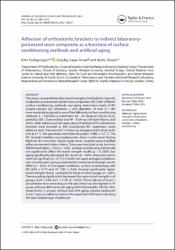| dc.contributor.author | Yüzbaşıoğlu, Emir | |
| dc.contributor.author | Sayar Torun, Gülsilay | |
| dc.contributor.author | Özcan, Mutlu | |
| dc.date.accessioned | 10.07.201910:49:13 | |
| dc.date.accessioned | 2019-07-10T19:57:14Z | |
| dc.date.available | 10.07.201910:49:13 | |
| dc.date.available | 2019-07-10T19:57:14Z | |
| dc.date.issued | 2016 | en_US |
| dc.identifier.citation | Yüzbaşıoğlu, E., Sayar Torun, G. ve Özcan, M. (2016). Adhesion of orthodontic brackets to indirect laboratory-processed resin composite as a function of surface conditioning methods and artificial aging. Journal Of Adhesıon Science And Technology, 30(23), 2565-2572. https://dx.doi.org/10.1080/01694243.2016.1186327 | en_US |
| dc.identifier.issn | 0169-4243 | |
| dc.identifier.issn | 1568-5616 | |
| dc.identifier.uri | https://dx.doi.org/10.1080/01694243.2016.1186327 | |
| dc.identifier.uri | https://hdl.handle.net/20.500.12511/2932 | |
| dc.description | WOS: 000379137300004 | en_US |
| dc.description.abstract | This study compared the shear bond strength of orthodontic brackets to laboratory-processed indirect resin composites (IRC) after different surface conditioning methods and aging. Specimens made of IRC (Gradia Indirect, GC) (thickness: 2 mm; diameter: 10 mm) (N = 80) were randomly assigned to one of the following surface conditioning methods: C-Control: no treatment; AA - Air-abrasion (50 mu m Al2O3 particles); DB-Diamond bur and HF - Etching with hydrofluoric acid (9.6%). After adhesive primer application (Transbond XT), orthodontic brackets were bonded to the conditioned IRC specimens using adhesive resin (Transbond XT). Following storage in artificial saliva for 24 h at 37 degrees C, the specimens were thermocycled (x1000, 5-55 degrees C). The IRC-bracket interface was loaded under shear in a Universal Testing Machine (0.5 mm/min). Failure types were classified using modified adhesive remnant index criteria. Data were analyzed using two-way ANOVA and Tukey's HSD (alpha = 0.05). Surface conditioning method did not significantly affect the bond strength results (p = 0.2020), but aging significantly decreased the results (p = 0.04). Interaction terms were not significant (p = 0.775). In both non-aged and aged conditions, non-conditioned C group presented the lowest bond strength results (MPa) (p < 0.05). In non-aged conditions, surface conditioning with DB (8.03 +/- 0.77) and HF (7.87 +/- 0.64) showed significantly higher bond strength results compared to those of other groups (p < 0.05). Thermocycling significantly decreased the mean bond strength in all groups (2.24 +/- 0.36-6.21 +/- 0.59) (p < 0.05). The incidence of Score 5 (all adhesive resin remaining on the specimen) was the highest in HF group without (80%) and with aging (80%) followed by DB (40, 70%, respectively). C groups without and with aging showed exclusively Score 1 type (no adhesive resin on the specimen) of failures indicating the least reliable type of adhesion. | en_US |
| dc.language.iso | eng | en_US |
| dc.publisher | Taylor & Francis Ltd | en_US |
| dc.rights | info:eu-repo/semantics/openAccess | en_US |
| dc.subject | Adhesion | en_US |
| dc.subject | Aging | en_US |
| dc.subject | Bond Strength | en_US |
| dc.subject | Indirect Resin Composite | en_US |
| dc.subject | Orthodontic Brackets | en_US |
| dc.subject | Surface Conditioning | en_US |
| dc.title | Adhesion of orthodontic brackets to indirect laboratory-processed resin composite as a function of surface conditioning methods and artificial aging | en_US |
| dc.type | article | en_US |
| dc.relation.ispartof | Journal Of Adhesıon Science And Technology | en_US |
| dc.department | İstanbul Medipol Üniversitesi, Diş Hekimliği Fakültesi, Protetik Diş Tedavisi Ana Bilim Dalı | en_US |
| dc.authorid | 0000-0001-5348-6954 | en_US |
| dc.identifier.volume | 30 | en_US |
| dc.identifier.issue | 23 | en_US |
| dc.identifier.startpage | 2565 | en_US |
| dc.identifier.endpage | 2572 | en_US |
| dc.relation.publicationcategory | Makale - Uluslararası Hakemli Dergi - Kurum Öğretim Elemanı | en_US |
| dc.identifier.doi | 10.1080/01694243.2016.1186327 | en_US |
| dc.identifier.wosquality | Q3 | en_US |
| dc.identifier.scopusquality | Q2 | en_US |


















